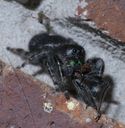Bold Jumper
Phidippus audax
Classification
- Phylum: Arthropoda
- Subphylum: Chelicerata
- Class: Arachnida
- Order: Araneae
- Infraorder: Araneomorphae
- Family: Salticidae
- Genus: Phidippus
- Species: audax
Pronunciation
How to pronounce Phidippus audax: /ˈfaɪdɪpəs ˈɔːdæks/
These audio files are automatically generated. While they are not always 100% accurate, they are a good starting point.
Images






Summary
Phidippus audax, or the Bold Jumper, is a highly adaptable and abundant jumping spider known for its remarkable vision, hunting prowess, and role in controlling agricultural pest populations. It is recognized by its distinctive markings and has made cultural significance as the state spider of New Hampshire.
Physical Characteristics
Adult female ranges from 8-15 mm; male ranges from 6-13 mm. Typically black with a white triangle on the abdomen and two smaller spots below it. Chelicerae are iridescent green. Males have prominent leg banding. Females have longest fourth pair of legs.
Identification Tips
Distinguished by distinct white triangle and two smaller white spots on their abdomen. Presence of iridescent chelicerae. Males are smaller and have more striking markings.
Habitat
Found in grasslands, chaparrals, open woodlands, and agricultural fields. Often seen in gardens and inside homes, barns, and garages.
Distribution
Native to North America, widespread throughout the United States, southern Canada, and northern Mexico. Introduced to Hawaii, Nicobar Islands, Azores, and the Netherlands.
Diet
Solitary carnivores preying on a variety of insects and non-insect terrestrial arthropods including caterpillars, dragonflies, and grasshoppers. They consume many crop pests such as bollworms and stink bugs.
Life Cycle
Spiderlings hatch approximately 10 days after oviposition and undergo 6-7 more instars before reaching maturity, taking about 9 months from oviposition to sexual maturity.
Reproduction
Males prepare for mating by making a silk mat to release sperm. Courtship involves elaborate displays. Females construct egg-sacs containing 30-170 eggs in hidden areas and guard them during incubation.
Predators
Species of spider wasps, thread-waisted wasps, lizards, dragonflies, birds, and other spiders.
Ecosystem Role
Considered a significant predator of crop pests in agricultural areas.
Cultural Significance
Designated as the state spider of New Hampshire in 2021 after a campaign by a classroom.
Health Concerns
Bites are rare and typically mildly painful. Medical attention is advised if symptoms worsen, but are generally not considered dangerous.
Evolution
Part of a clade with similar Phidippus species distinguished by anatomical traits. Closest relative is Phidippus bidentatus due to shared morphological features.
Similar Taxa
Misconceptions
Despite their bite being mildly painful, they are not considered dangerous to humans and often avoid confrontation when approached.
Tags
- spider
- Phidippus audax
- jumping spider
- North America
- carnivore